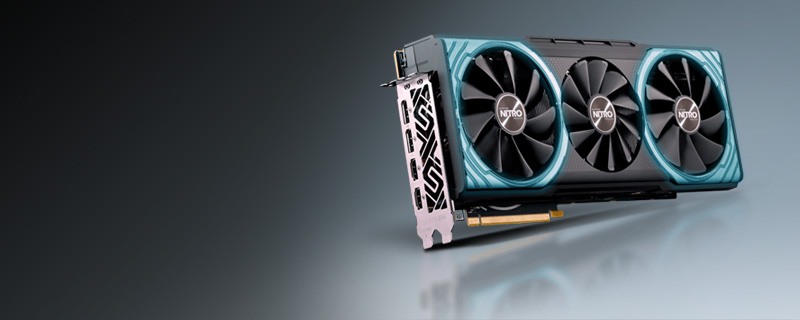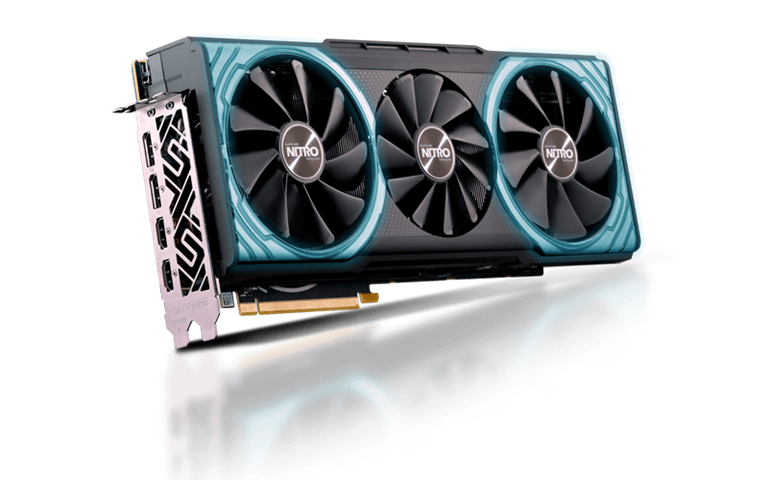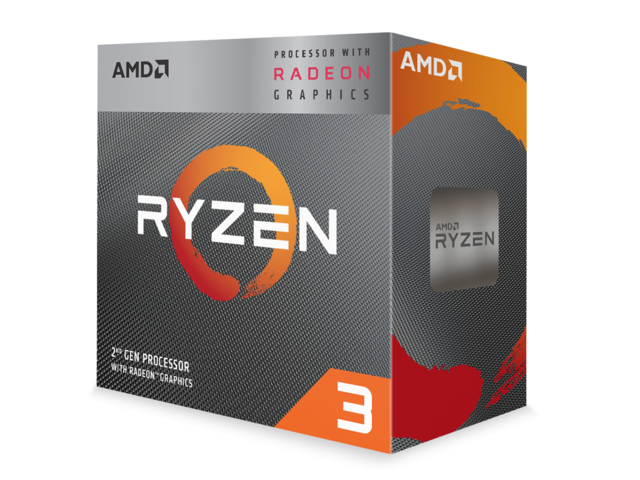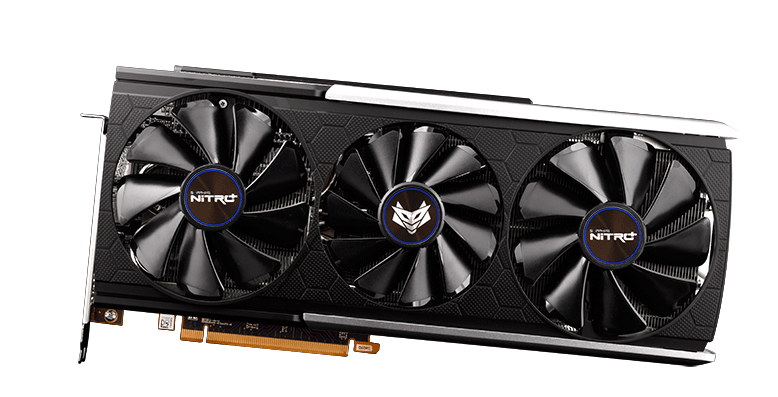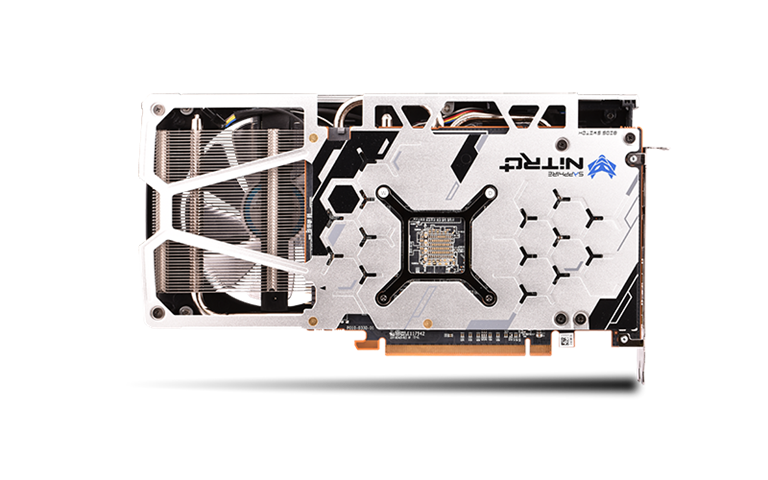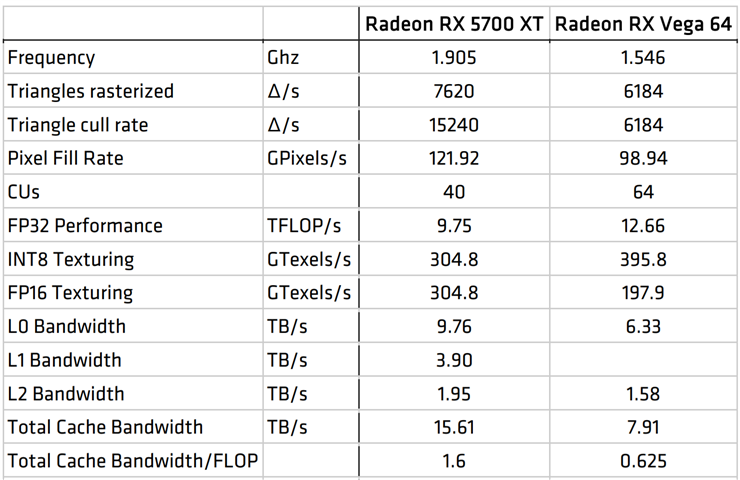
This is a continuation of our previous article on this topic – the Evolution of GCN. Today we will be looking at the final showing of this legendary architecture and will also be taking a look at the current champion that features the RDNA 1 based RX 5700 XT, as well as the highly anticipated RDNA 2 and CDNA!
GCN 5 – Vega
Seen in: Vega 10, Vega 12, Vega 20, Vega iGPU 1st and 2nd Gen
Vega Frontier Edition, RX Vega 56 and 64, Radeon VII, Vega SSG, Raven Ridge, Picasso, Renoir
While we touched upon Vega originally, we now know a lot more about this architecture. Its DNA is the basis for AMD’s upcoming CDNA compute architecture and the current RDNA graphics architecture. It also has full support for almost all DX12 and Vulkan features, an upgrade over Polaris and older architectures.
Vega has a lot of changes and features introduced within it. The first is a substantial increase in clock speeds. While the clock speed of a product is to a large extent dictated by its process, architecture too plays a key role. Vega 10 GPUs have increased speed and lower latencies inside them compared to previous GCN revisions. This increase in clocks allowed its beefy quad-geometry engine array to easily eat up excessive geometry and tessellation alike, even better than Polaris. To aid in this endeavor, the doubled L2 cache and second-generation Primitive Discard Accelerator (PDA) were introduced. Even tessellation monsters like The Witcher 3’s hairworks effects perform admirably on Vega GPUs, even when compared to their competition.
The other most interesting piece of technology was the HBCC. This was put to good use in the Radeon SSG and allows for the Vega chip to use its extremely potent HBM2 as cache, while using RAM and system storage as extensions of its own beefy memory systems.
For professionals working with large files, this was a godsend. The Radeon SSG paired this technology with a custom SSD so as to get even higher mileage of this technology. For gamers though, it was more niche. Even nowadays, few games actually make use of more than 8GB of VRAM. Still, some high-end modders did appreciate this feature as it meant that performance would not tank when gigantic, high-quality textures were in use.
Other performance enhancing features include the Rapid-Packed math, which saw its debut in engines like id Tech 6.5 and games like Wolfenstein 2. Allowing for the execution of certain effects at half the precision but double the speed, it is a great performance enhancing feature, especially since it is usually deployed on effects that really do not need to look exact yet are incredibly stressful on the GPU. For example, fire and explosions in the aforementioned game. This feature is gaining traction among all modern GPUs and is a great feature to use in DX12 and Vulkan that is slowly seeing adoption in games. It is also one of the building blocks that will lead to Ray-Tracing performance in future products based on the as of now unreleased RDNA 2 architecture.
We cannot ignore the DSBR (draw stream binning rasterizer) that was introduced with Vega. While first generation, it is able to improve bandwidth efficiency in some applications and scenes.
RX Vega 56 Pulse with its large, overhang cooler – this enables even more efficient cooling. While possible in classic designs (see our RX 5700 Nitro+ using GDDR6) HBM makes it easier!
One must also mention the revolutionary introduction of HBM2 in the mainstream market. Fiji-based products like the Fury X were the first to use the initial version of this memory technology. Vega is the first consumer-grade GPU to support the much improved HBM2 standard. Enabling much higher memory amounts, even lower latencies, using fewer transistors on the memory controller, and better performance per watt, HBM2 is indeed awesome. It also allows for much smaller PCB designs that can enable better or cheaper GPU cooling, if designed well. Also, while having less bandwidth on paper than Fiji, even a RX Vega 56 with “only” 410 GB/s actually has higher effective memory bandwidth than a Fury X – Delta Colour Compression and cache speeds matter a lot!
This awesome little 3200G combines 4pretty good Zen+ cores with 8 Vega cores.
While we were mostly looking at dedicated GPUs, it is important to acknowledge Vega’s success on mobile and desktop APUs. Modified Vega cores are in popular, beloved products such as the 2200G, 3400G, and the new Ryzen 4000 APUs on mobile and desktop products.
They are basically the same cores as the desktop Vega 10 / Vega 20, but with an upgraded display engine and tuned infinity fabric, for maximum bandwidth. The 2nd generation of the design in Renoir (4000 series APUs) is a clear step up. It is faster with 8 Vega cores than Picasso (3000 series) was with 11. All of this is due to improved internal latencies, better interconnect and a rebuilt cache. Of course, the improved memory controllers and higher clock speeds (thanks to 7nm!) helped a lot too. Not bad for a tiny integrated GPU, not bad at all!
But what about the second generation of Vega?
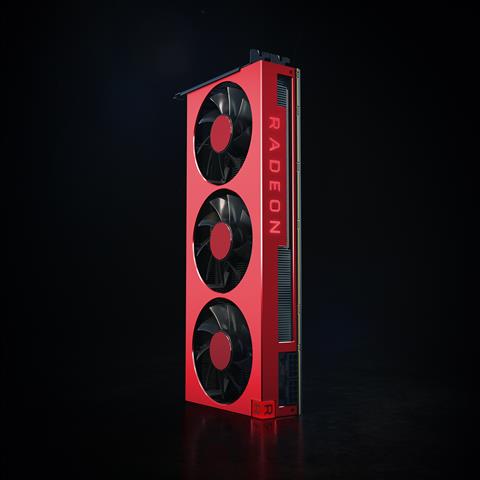
This bad boy is above is the Radeon VII, a 7nm product based on the MI50 and MI60 series of professional GPUs. Its core is the Vega 20 GPU, the second generation of Vega and the first PCIE4 GPU in the world (though only the professional versions have that) as well as the first 7nm GPU.
AMD went back and redesigned some parts of the elder monster here. Vega 20 features improved internal latencies, redesigned fabrics for faster speeds inside the chip itself, even higher clock speeds and higher levels of mixed-precision compute performance. The ability to do INT8 and INT4 is a welcome improvement as well, handy for AI, while the awesome FP64 improvements help a lot with HPC use. Add a solid quad-HBM2 design using even more advanced chips with higher bandwidth (up to 1 TB/s!), and one can see the making of one really powerful piece of silicon.
Vega 20 is valuable for professionals and prosumers alike, with the Radeon VII carving out its niche among people who can use its performance for their workflow. A variant of these monsters also exists for Apple’s machines, helping crunch through tasks there too. While very fast in games, it is not the optimal choice for a pure gamer, unless the price is right that is.
The Vega series from AMD is long-lived, going on for 3 whole years now. It was a rocky architecture with many ups and downs. It is the last showing of the venerable soldier that is GCN and while it didn’t really live up to all of its hype and promises, it still had some amazing products under its belt. Among all the drama, we cannot forget it is the heart of the finest integrated graphics around, making for excellent home-theater PCs, allowing poorer regions to dabble into PC Gaming and allowing AMD to re-enter the lucrative mobile market. A few audacious prosumer and professional cards, as well as outstanding gaming products like the RX Vega 56, show that this troubled architecture still managed to do its job quite well with the appropriate price. It is true that performance per watt and die size were real issues for this beast, at least for the gaming line, but it still allowed AMD to finally re-enter the HPC, AI, Production, and Server markets. A lot more work has to be done there, but this step forward is still very important.
RDNA 1 – The new era is here!
Seen in: Navi 10, Navi 12
RX 5700 XT, RX 5700, RX 5600 XT, RX 5500 XT
Radeon DNA or RDNA for short is the current most up to date gaming architecture from AMD. It is in use in the current Navi GPUs from AMD which are the backbone of products like the RX 5500 XT or RX 5700.
Just like GCN 1 before, RDNA represents a radical shift in design. With RDNA, AMD decided to address key weaknesses in their GCN-based designs – namely underutilization in most games.
To achieve this, the entire GPU was more or less rebuilt from the ground up to work in a different manner. The biggest change here relates to the “wavefront” (basically a group of work), from 64 in Vega, to 32. Now, what was happening on GCN parts was that they rarely managed to fill in their work group fully which meant that while the GPU was working hard, it was not actually doing work efficiently. Filling up the smaller que is obviously easier than the larger one. Even extremely optimized, compute-heavy titles like Wolfenstein 2 were barely able to reach 60% saturation on a Vega 64. This happens much less on Navi parts with this one, really big change. This also means that RDNA GPUs are faster in less optimized APIs like OpenGL and DX9 than previous AMD designs.

When using the more efficient wave32 wavefronts over wave 64, the GPU has higher IPC and cuts latency too!
Another really important update is the redesigned cache systems. Having a large L2 cache is great and all, but the added L0 and redesigned L1 caches inside these new chips are of tremendous help for the chip. This too helps utilization in games.
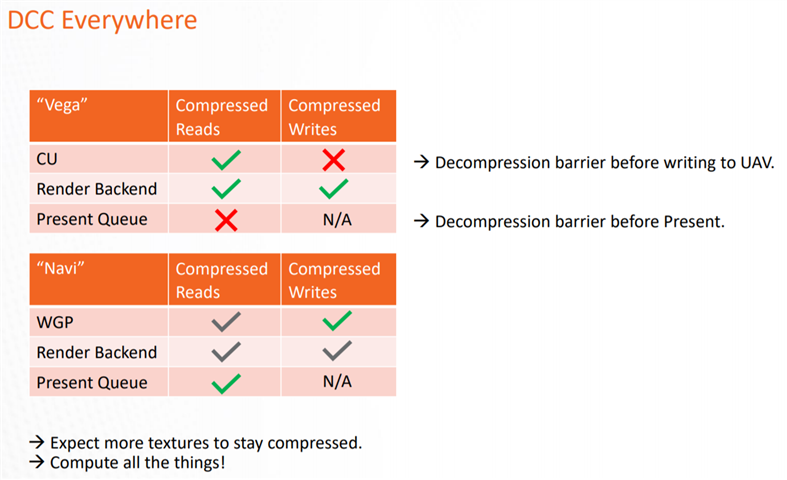
The next generation of AMD’s Delta Colour Compression also made its debut here and is now able to achieve 50%+ more effective bandwidth. This combined with the cache changes means that despite having “only” 448 GB/s of bandwidth, a RX 5700 XT actually has more effective bandwidth than a Vega 64 or a Fury X!
The next massive jump is related to geometry and tessellation. Vega was really quick here, but the higher clocks and superior culling mechanisms of RDNA are even quicker. The faster clearing of its caches allows it to better adapt to complex scenes and reuse more triangles where possible. Also, Navi can finally use a version of primitive shaders, allowing it to quickly remove unneeded geometry and tessellation from a scene without wasting too much time. These are things players cannot ever see, so there is no loss to fidelity at all, only more FPS and better GPU utilization. Of course, a bump to clock speeds helps a bit more as well, since the higher the clocks, the faster the geometry processors are.
While HBM2 and its current variant – HBM2E are awesome memory standards, they also cost a lot. And cost is a very important part when one wants to make a great product. Here AMD decided to use the new, cheaper but still very fast GDDR6. It is more efficient than GDDR5, much faster, and easy to design around. A very good call for the current RDNA GPUs!
Improved display engines and media engines, first demonstrated with the Vega integrated GPUs’ are now standard all across the lineup and upgraded further still. These new parts will allow for more efficient media processing and better support for the displays of tomorrow. While a minor point for gamers, this unification and improvement of these technologies also helps AMD cut down on development time which will for sure be welcome for future displays. Plus, an even better experience while browsing our favourite media is always a good thing!
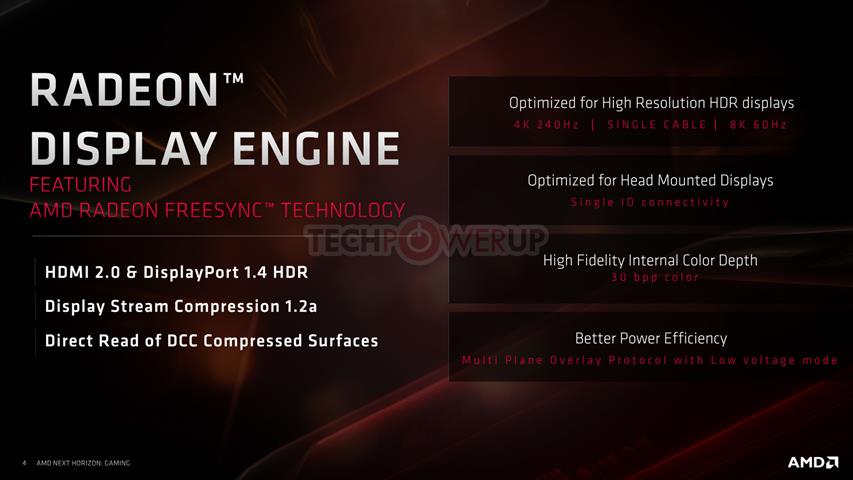
Finally, RX 5000 series GPUs are the first consumer GPUs to support PCIE4, almost doubling the bandwidth between the CPU and GPU. A note to our viewers – if you have a PCIE 3 CPU and motherboard, fret not – they will still work with a RDNA 1 or RDNA 2 GPUs. In fact, in gaming there is no difference even with a RX 5700 XT, though it has shown gains in certain professional or compute applications. It is more of a step for the future.
A quick look at some of the differences between a RX 5700 XT and a Vega 64.
All these changes and many more allow RDNA 1 to outperform its more power-hungry and larger predecessors, the RX Vega 56 and 64, in gaming and equal them in many compute tasks. RDNA 1 represents a massive leap over GCN for consumer graphics. It keeps backwards compatibility and is able to use GCN’s Wavefront 64 very well too. While it is not quite the compute monster that the Vega 20 is, RDNA is a modern architecture – it is still very good at compute. It is currently the most up-to-date 7nm GPU architecture from AMD and is very competitive in all gaming scenarios while keeping costs in check and offering very high technology all around. In the here and now, Navi products like the RX 5700 XT NITRO+ or the RX 5700 PULSE have great value for gamers and can crunch through titles both new and old very well!
A bright future – CDNA and RDNA 2
A showcase of future ray-tracing hardware!
We will finish off with a look towards the future once more. The next generation of graphics from AMD that should come out this year is called RDNA 2. Details are scarce at this moment in time, but it is the technology powering both next-generation consoles – the Xbox Series X and the PlayStation 5. It will add even more performance-saving features like Variable-Rate Shading and also showcase real-time Ray Tracing, the holy grail of computer graphics. We will see the new era of ray tracing in gaming for the mass market and hopefully – chips that power through even the most challenging old and current titles. A lot of the technology introduced in Hawaii, Fiji, Polaris, Vega and RDNA 1 are the basis for this revolution and we cannot wait to see it in action.
As for CDNA – this mysterious monster is not for gamers per say. It is a compute heavy machine, sharing even more of its DNA with Vega and GCN in general, it is not meant to play games but solve problems for the HPC, server, and AI markets. Alas, we know even less about it than we do for RDNA 2, so stay tuned for a part 3 eventually!
One thing is for certain – AMD now has different designs for both markets. It’s time to prove they can satisfy both markets with bespoke solutions that will leave all of us gamers and designers happy while helping the scientists and engineers of today make a brighter tomorrow for us all!
The articles content, opinions, beliefs and viewpoints expressed in SAPPHIRE NATION are the authors’ own and do not necessarily represent official policy or position of SAPPHIRE Technology.





